In 2023, the Navy sampled drinking water wells near Naval Weapons Station (NWS) Earle
to test for certain per- and polyfluoroalkyl substances, commonly known as PFAS.
For questions about this sampling, please contact the NWS Earle Public Affairs Office at colt.wpnstaearlepao@navy.mil or (732) 866-2171.
Introduction
Per- and polyfluoroalkyl substances (PFAS) are a family of thousands of different chemicals which have been widely used in industrial and consumer products since the 1950s. PFAS are man-made and have been used in many household and industrial products because of their stain- and water-repellent properties. PFAS are now present virtually everywhere in the world. The Navy and Department of Defense (DoD) have developed proactive policies to address past releases of PFAS, including perfluorooctanoic acid (PFOA) and perfluorooctane sulfonate (PFOS), at installations nationwide. The most common activity that could have resulted in the historical release of PFOA, PFOS, and other PFAS to the environment at Navy installations is the use of firefighting foam (specifically, aqueous film-forming foam, or AFFF) for testing, training, firefighting, and other life-saving emergency responses. Because of this historical use, there is potential for PFOA, PFOS, and other PFAS to be in the groundwater on base, and may be present in nearby drinking water wells that are located in the direction that the groundwater flows away from the base.
Once these compounds are released, many of them tend to stay in the environment for a very long time. Although the United States Environmental Protection Agency (EPA) has started the process to establish regulatory levels for several PFAS in drinking water, there are currently no Safe Drinking Water Act regulatory standards. The EPA has developed drinking water health advisories for a small number of PFAS; these advisories are non-enforceable and non-regulatory. The advisories provide technical information to states and other public health officials on health effects, analytical methodologies, and treatment technologies. For now, the Navy is continuing to follow the policy it issued in June 2016 to conduct investigations at installations where there has been a known or suspected release of PFAS to the environment. The first priority with these investigations is to ensure that PFOA and PFOS concentrations in drinking water wells are not above 70 ppt, individually or combined, as a result of Navy operations.
DoD, including the Navy, is moving toward complete removal of AFFF at its installations and transitioning to PFAS-free alternatives to AFFF. Until that transition is complete, the Navy will continue to use formulations that contain lower concentrations of PFOA and PFOS than many historical AFFF formulations and will continue to take steps to prevent or minimize additional release of firefighting foam to the environment.
On March 14, 2023, the EPA proposed a draft regulatory drinking water standard for certain PFAS, including PFOA and PFOS. In response, DoD has issued the following statement: "DoD respects and values the public comment process on this proposed nationwide drinking water rule and looks forward to the clarity that a final regulatory drinking water standard for PFAS will provide. In anticipation of the final standard that EPA expects to publish by the end of 2023, the DoD is assessing what actions DoD can take to be prepared to incorporate EPA’s final regulatory standard into our current cleanup process, such as reviewing our existing data and conducting additional sampling where necessary. In addition, DoD will incorporate nationwide PFAS cleanup guidance, issued by EPA and applicable to all owners and operators under the federal cleanup law, as to when to provide alternate water when PFAS are present."
Off-Base Drinking Water Sampling at NWS Earle (Figure 1)
PFOA and PFOS have been detected in groundwater at NWS Earle above 70 ppt. When a known or suspected release of PFAS is identified on a Navy installation and groundwater is used as drinking water, a sampling area is established 1 mile in the direction that groundwater flows away from a release area. The Navy offers sampling to all property owners and tenants whose property is within the sampling area and whose drinking water is supplied by groundwater.
Figure 1: Location Map of NWS Earle
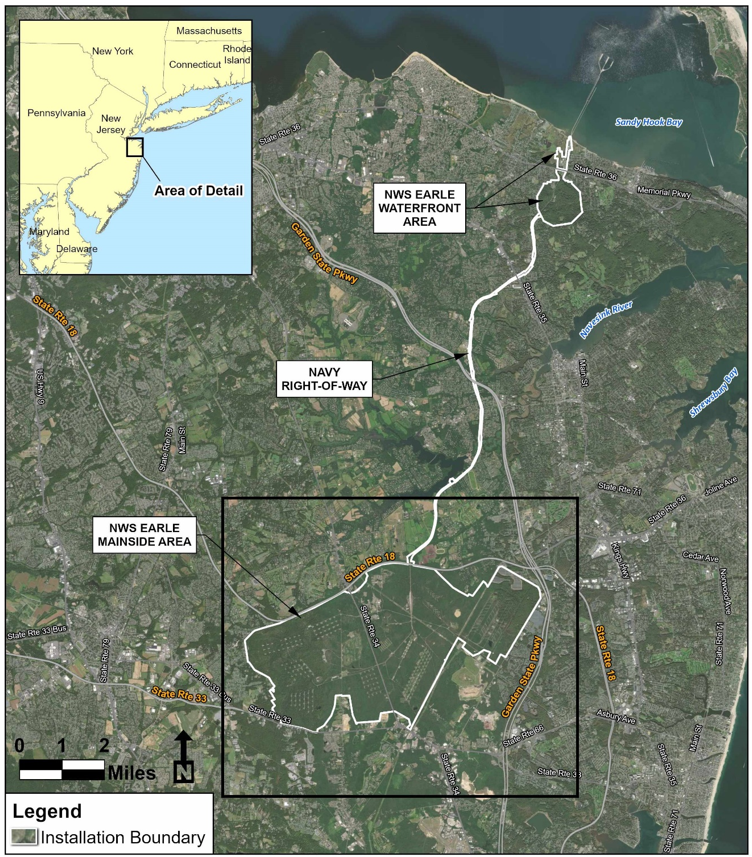
In 2015, early in the on-base investigation, PFOA and/or PFOS were detected in groundwater above 70 ppt at one release area, Site 46. As a result, an off-base sampling area was established in 2016 a half mile1 in the direction that groundwater flows away from Site 46 (Figure 2). Off-base drinking water well sampling was conducted in 2016.
In 2021, as the on-base investigation continued, PFOA and/or PFOS were detected in groundwater above 70 ppt at two release areas, Site 46 and Building C-63 (Figure 2). As a result, off-base sampling areas were established in 2023 1 mile in the direction that groundwater flows away from these two release areas. The Southwest Sampling Area is located in the direction groundwater flows off-base from Site 46, and the North Sampling Area is located in the direction groundwater flows off-base from Building C-63 (Figure 2). Records indicate that some properties within the sampling areas are provided drinking water by NJ American. NJ American customers should contact NJ American with any questions regarding their drinking water.
1 The half-mile sampling area was determined before Navy policy came out specifying that off-base drinking water sampling areas be determined as a distance 1-mile downgradient of known or suspected Navy PFAS releases.
Figure 2: 2016 and 2023 NWS Earle Off-Base Drinking Water Sampling Areas

Actions Based on Off-Base Drinking Water Sampling Results
The preliminary results from off-base drinking water sampling are expected approximately 30 days after collecting the samples. The Navy provides notification to property owners and tenants of their drinking water results and any follow-up actions, if needed. The Navy will do its best to keep the testing results and property information confidential to the extent permitted by law.
The Navy will provide bottled water for drinking and cooking to any property in the sampling area with a drinking water well that contains PFOA and/or PFOS above 70 ppt and does not have an alternate drinking water source available. The Navy will continue to provide bottled water until a permanent solution is implemented.
2016 Off-Base Drinking Water Sampling
The Navy conducted off-base PFAS drinking water well sampling in 2016 based on information that was available at that time regarding potential releases of PFAS on-base. The 2016 sampling area, shown in Figure 3, was established 0.5 mile in the direction that groundwater flows away from the release area. Tables 1 and Figure 3 provide a summary of the results of the 2016 sampling. Table 2 presents the PFOA, PFOS, and PFOA+PFOS results. PFOA and/or PFOS were detected above 70 ppt in two drinking water wells. Bottled water was provided to the two properties with PFOA and/or PFOS results above 70 ppt until they were connected to public water (NJ American) in December 2016.
2023 Off-base Drinking Water Sampling
In April 2023, the Navy began sampling drinking water wells within the sampling areas near NWS Earle (Figure 2). Table 1 summarizes the drinking water sampling results. Tables 3 and 4 and Figures 4 and 5 present the PFOA, PFOS, and PFOA+PFOS results. PFOA and/or PFOS were not detected above 70 ppt.
Table 1. Off-Base Drinking Water Well Sampling Results Summary as of September 15, 2023
| Sampling Area |
Number of Wells Sampled |
Number of Wells with No Detections of PFOA or PFOS |
Number of Wells with Detections of PFOA and/or PFOS Below 70 ppt |
Number of Wells with Detections of PFOA and/or PFOS Above 70 ppt |
| 2016 |
29 |
23 |
4 |
2 |
| |
| 2023 North |
46 |
40 |
6 |
0 |
| 2023 Southwest |
41 |
35 |
6 |
0 |
Table 2. 2016 Off-Base Drinking Water Well Sampling Results
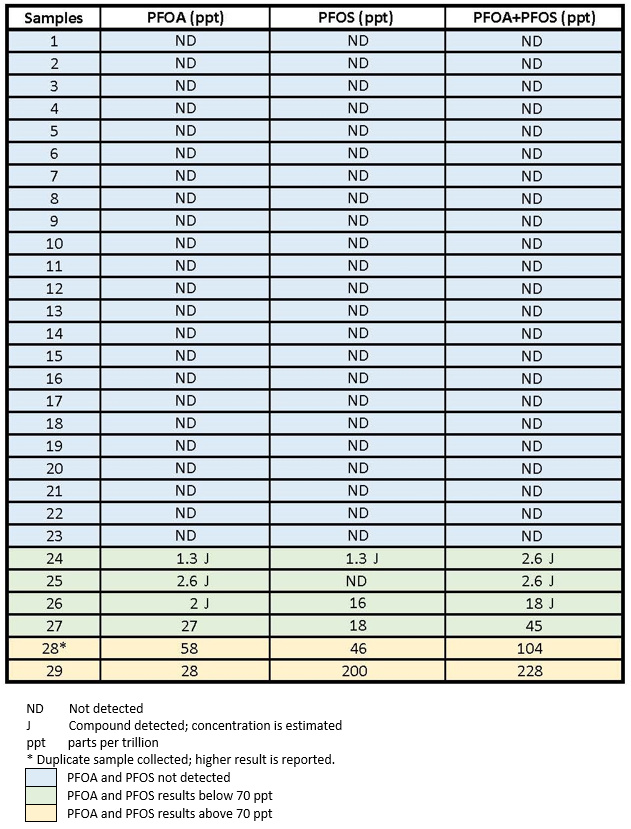
Figure 3. 2016 Off-Base Drinking Water Well Sampling Results
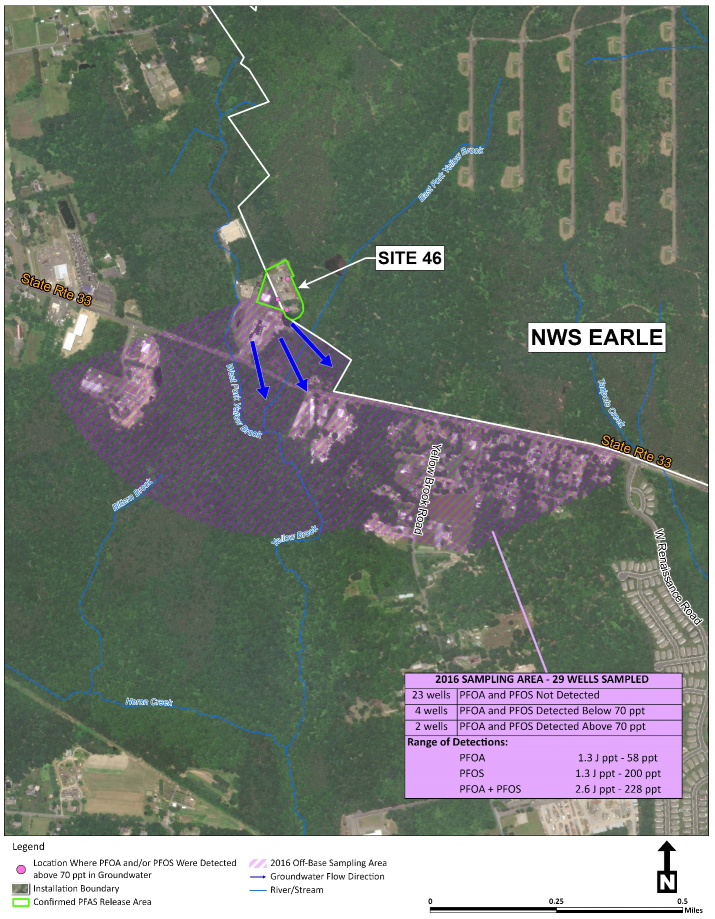
Table 3. 2023 North Sampling Area
Off-Base Drinking Water Well Sampling Results (as of September 15, 2023)
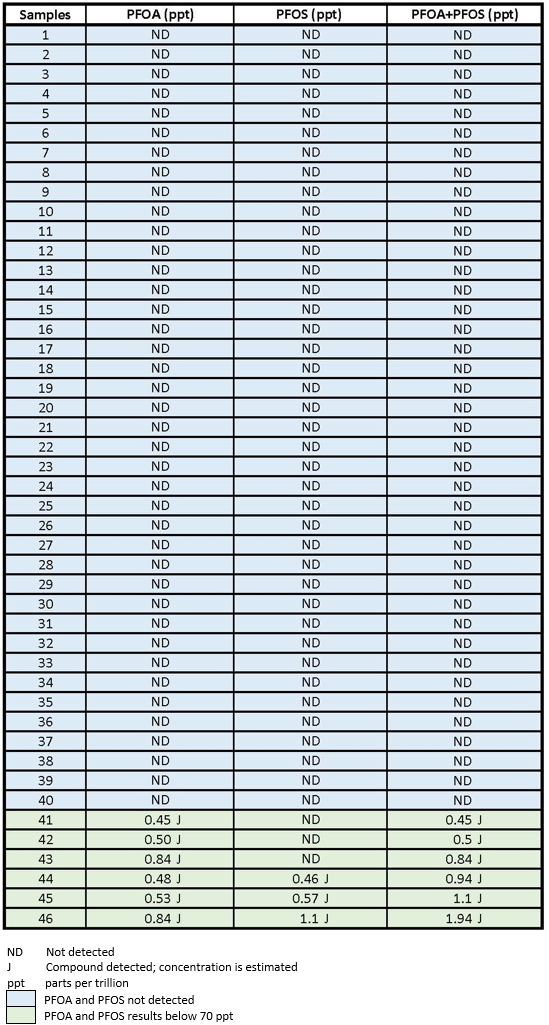
Figure 4. 2023 North Sampling Area
Off-Base Drinking Water Well Sampling Results (as of September 15, 2023)

Table 4. 2023 Southwest Sampling Area
Off-Base Drinking Water Well Sampling Results (as of September 15, 2023)

Figure 5. 2023 Southwest Sampling Area
Off-Base Drinking Water Well Sampling Results (as of September 15, 2023)
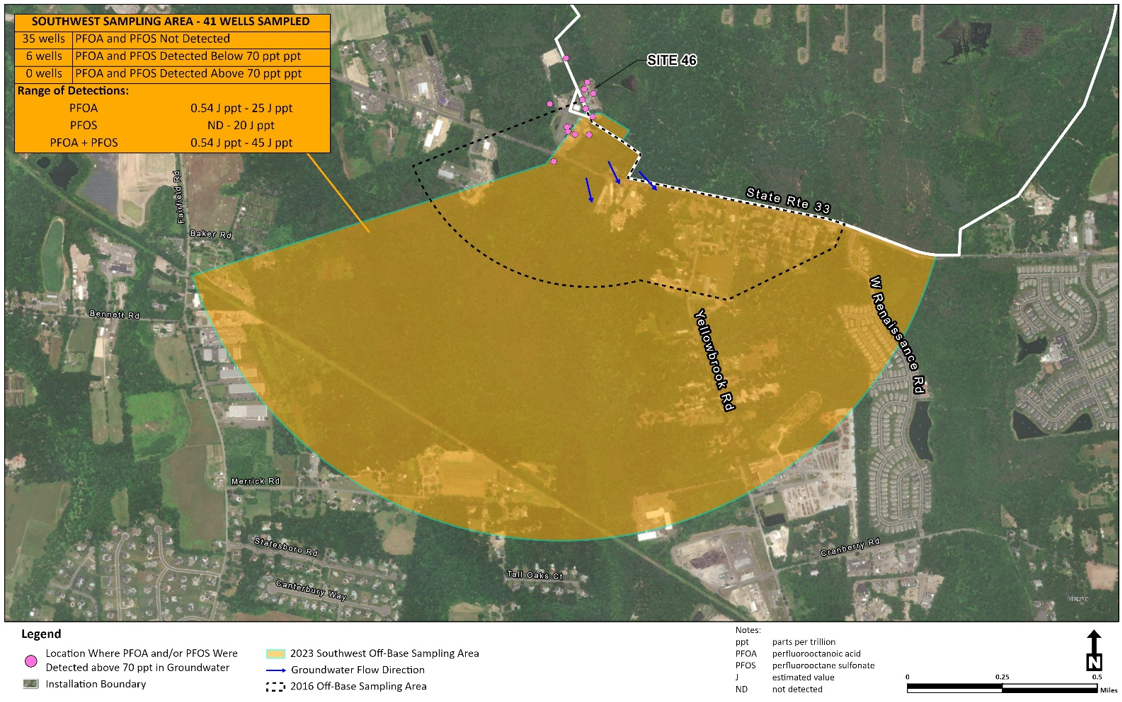
Identification of PFAS Releases at NWS Earle
Site 46 was identified as a PFAS release area in 2015, and investigation of groundwater and soil is ongoing. Site 46 is currently in the Remedial Investigation phase.
The basewide Preliminary Assessment (PA) for NWS Earle was completed in January 2020, and identified the following eight on-base areas, shown on Figure 6, where releases of PFAS may have occurred.
-
Site 3: Landfill Southwest of “F” Group
-
Site 4: Landfill West of “D” Group
-
Site 5: Landfill West of Army Barricades
-
Site 6: Landfill West of Normandy Road
-
Historical Fire Training Area (Location of Site 11 – Ordnance Disposal Area)
-
Site 13: Defense Property Disposal Office Yard Landfill
-
Building C-63: Hazardous Waste Storage Building
-
Site 49: Shed S-469 and Wooded Area
These areas are on the NWS Earle Mainside Area, except for Site 6, which is on the NWS Earle Waterfront Area.
Figure 6: PFAS Release Areas
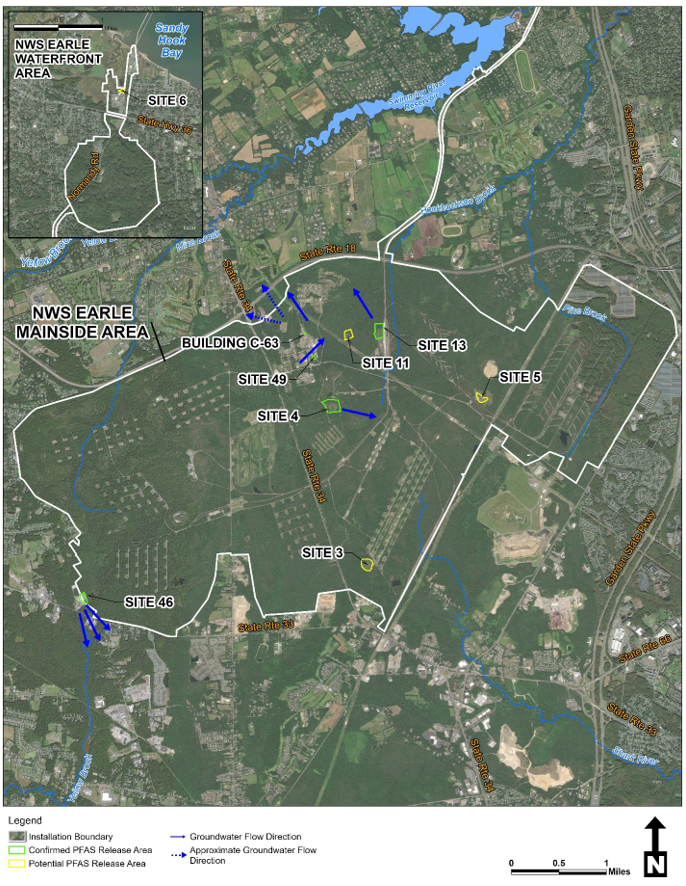
In the summer of 2021, sample collection and analysis of groundwater was completed at these areas in support of a Site Inspection (SI). The Navy is currently evaluating what additional investigations are necessary.
NWS Earle Off-Base Drinking Water Sampling Documents
Additional Documents
Links